#Tabar Axe
Explore tagged Tumblr posts
Text
Ra's al Ghul and Boy
He had been Ra's first child before he had any other child of his own blood. Had been a boy he found while on his travels, he and him spoke not the same language. So I just called the boy, Wulid which means Boy. and took him with him. + Danny wasn't sure; it was while on the hunt for a ghost group that traveled in the past to help their past self conquer better. But here he is with that old man, who was the enemy of that ghost alive self too. Danny was happy as he told him he would help him. That led to him getting trained and mentored by the old man who joined him in the fights. + Ra was using a Tabar (axe) during the battle, while the boy stayed back with a dagge, or bow. Or he left to use his powers while fighting against the super-powered one. The boy looked very shocked as he saw how Ra was able to fight the ghosts and hurt them without a ghostly weapon. But if you bathe so much in the pit, you are able to hurt beings that aren't fully in their world or between them. +
After the old man died while fighting against that invasion, Danny too left. He told them he would capture the rest and then leave. Danny had no idea that the old man would be brought back to life by his cult. As Danny never fully meet the full group of it. + As Ra was taken out of the Lazarus Pit, he learned his student had left, thinking he had died. Maybe Ra should have told him about the pit. As he was unable to find him, the island sank, where he had his last battle. + A/N - -Yes, just think before you, Kratos and Atreus, for Ra's al Ghul and Danny. - Tabar is an old Arabic axe. - Ra was much nicer to Respawn, as he made him think of Danny. Respawn is his favorite grandchild.
#Ra's al Ghul#danny fenton#danny phantom#dp x dc#dc x dp#dp + dc#dc comics#dp#dc#dcau#batman#Respawn#Kratos and boy Meme#time travel#Tabar Axe#“Boy” Danny#yes Ra's call danny boy at the start for a long time#Ra's first child
564 notes
·
View notes
Text
The sword of the day is the tabar-shishpar.

The tabar-shishpar is a very rare variation on the Persian and Indian tabar axe I’ve previously featured. The “shishpar” in the name refers to the mace portion of the weapon; the name is a Persian phrase which translates to “six wings,” referring to the (usually) six flanges on the mace head. Like the non-shishpar tabar, this weapon was designed to be used on horseback.
39 notes
·
View notes
Text
These axes are made to order. Customers interested in purchasing axes, we are happy to inform you that we offer custom-made options. Please feel free to reach out via WhatsApp +919878920062 for more information.
#mahakaalarms
#axes
#axe
#tabar
#kuhada
#safajung
#buyaxeonline
#craftsmanship
#qualitywork
#akaalarms

0 notes
Text
In reaction to this post, @irlactualwizard wrote:
This is beautiful. On the note about maces and the like, they're traditionally horseback weaponry. I'm unsure of the usefulness or practicality of a dagger tucked away in a weapon primarily used from 'higher ground' or where CQC wouldn't be common. I mean, fall off the horse, drop the mace and draw the saber or katar. Although, redundancy is what keeps humans alive. It does strike me as odd that they wouldn't have shoved an extra weapon in just for the niche.
That notion of dropping the mace then drawing something else with longer (or for really close quarters, shorter) reach is something which may well have happened, though not just because it was an exclusively cavalry weapon. All the other weapons were also used from horseback, and in one instance its original Indo-Persian name is pretty specific about equestrian origins.
The zaghnal, that wicked pick-axe thing...
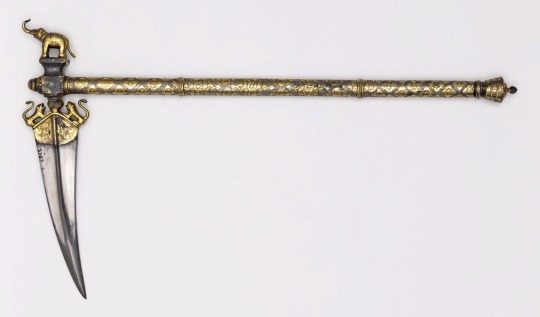
(yup, there's a dagger...)
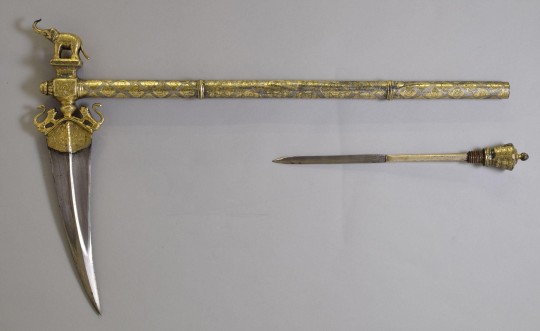
...has a European equivalent called a "horseman's pick" and supposedly copied from Ottoman weapons which would have been zaghnal-shaped; this one is Polish or Hungarian...

The hatchet-knife bhuj was - per Wikipedia, Bygone Blades and Oriental Arms - a popular weapon with the Gujarati and Sindhi cavalry, who also wore a distinctive style of full armour...
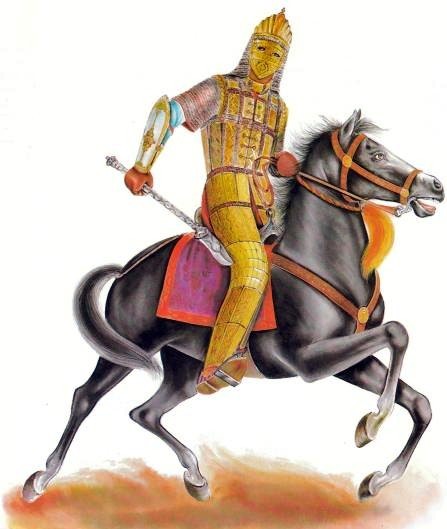
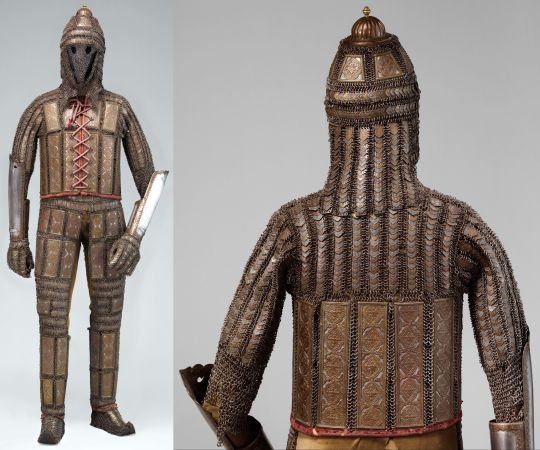

(yup, there's a dagger)

(This time there's a gun, and probably a dagger too because why not?)

Most conclusively, the proper name for Indo-Persian battleaxes is tabar / tabarzin, which means "saddle-axe".
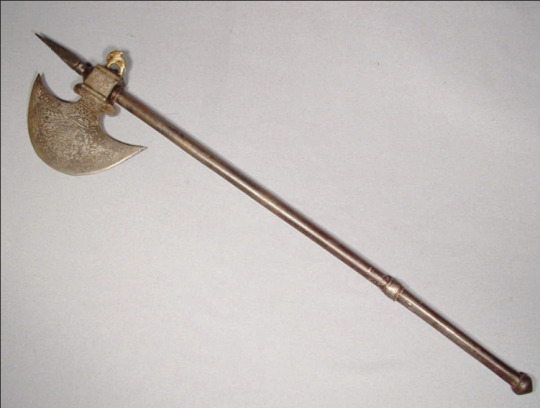
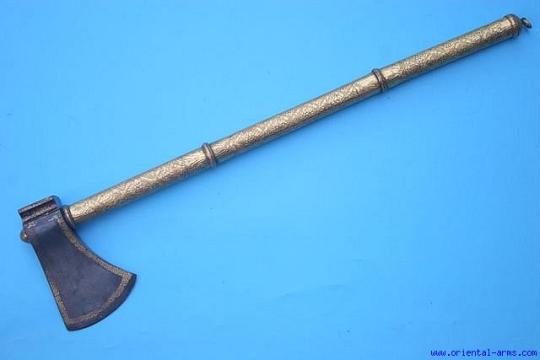
These included some of the few real-life examples of double-headed battleaxes (with daggers, but of course...)


Though popular in fantasy art, IRL usual practice was to have an axe on one side and something different like a hammer or pick on the other side in case the axe wasn't effective enough against whatever kind of armour the opponent was wearing.
And of course even single-headed axes often had the usual dagger tucked away.

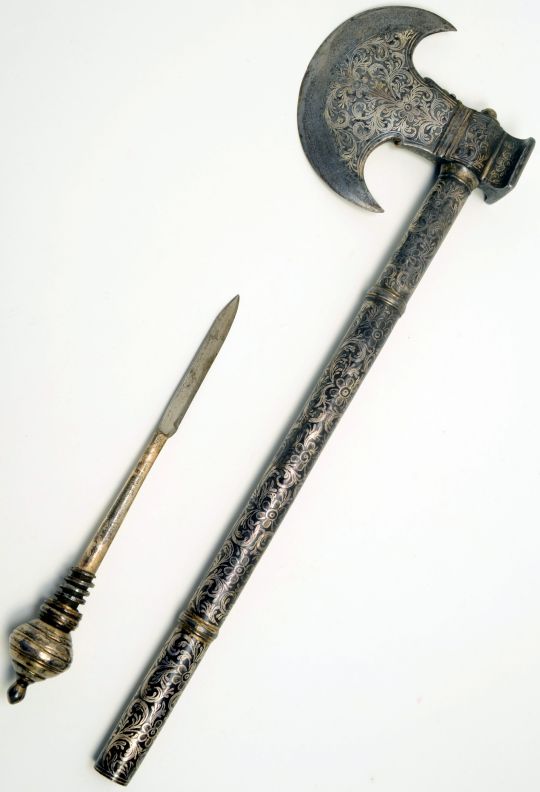
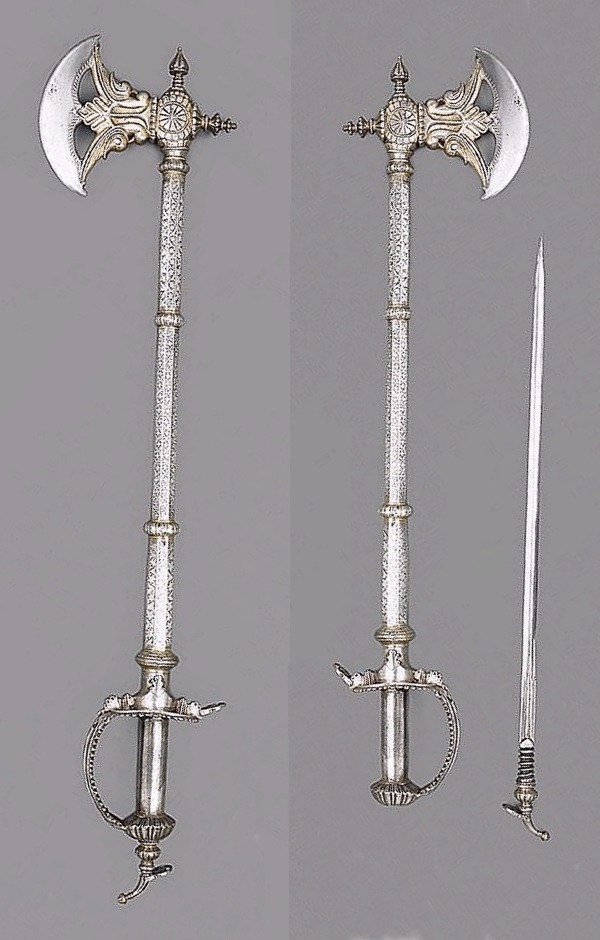
Here's yet another with a sword-hilt (also possibly a dagger) and a built-in matchlock gun...

And here's one where some warrior just couldn't make up his mind.

Here's a mace with a similar (khanda broadsword) hilt:

I took a close look at various mace-pics I've posted (here and here), something I should have done before, then searched further on-line, and I'm starting to think they had no daggers because mostly their hafts were solid rather than hollow...

Thanks go to @irlactualwizard for prompting me to track down an answer to my own question - though I'll be waiting for someone who knows far more about Indian weapons to correct me. :-P
Finally, here's a display case showing three more maces, a couple of the double- (here triple-) -bladed daggers called haladie, and a few examples of what Indian weaponsmiths could do with the basic concept of a sword blade...

...including making use of a European hilt, top row second left. Its blade may have been mounted on an Indian khanda or talwar hilt, which happened often enough to create a whole class of "firangi" (Frankish) swords.
There are many more pics on my blog and elsewhere. Once again, for fantasy edged-weapon inspirations, India is a great place to start...
:->
160 notes
·
View notes
Photo

This style of war axe, or tabar, known as the bullova, is uniquely associated with the Orissa people of India
8 notes
·
View notes
Text
Real-life combination weapons might be highly decorated Rich Boy Toys, or starkly functional military weapons.
They sometimes featured multi-shot revolvers, but usually took the form of one or several single-shot guns attached to some other weapon - spear, sword, dagger or axe - that would continue as a weapon after the gun(s) had been fired and there was no time to reload.
Here's a boar spear with paired wheel-lock pistols.


A set of table cutlery (!) with built-in flintlock pistols:

An "Elgin Cutlass" single-shot percussion pistol and a Bowie-knife pinfire revolver:


A sword with a double-barrelled flintlock pistol and a sabre pinfire revolver:


An Indian katar punch-dagger with a pair of flintlock pistols...

...and a tabar battleaxe with a matchlock gun and hidden dagger:


A couple of boarding axes with flintlock carbines:


And finally this extraordinary six-shot (five from the head, one down the haft) battleaxe, saved until last because of Reasons.

Nowadays this would be equivalent to a watch "with complications", the sort of watch with so many other functions that actually telling the time gets lost among them.


Back then...
Well, the Royal Armouries call it "Possibly a novelty or curiosity", and - like those watches - it's so elaborate that its primary function isn't primary any more.
In this case, it couldn't fulfil the basic battleaxe purpose of hitting people without risk of breaking some part of itself, and because the battleaxe head is hollow and its "edge" is a flat lid covering several gun muzzles, it was never much of an axe anyway.
Here's the RA description:
The axe-head with long fluke is hollow and contains five barrels, the muzzles concealed by a hinged cover forming the edge of the axe-blade. The topmost barrel is ignited by a matchlock fitted on the left side, the mechanism concealed by a brass plate in the form of a lion, the second by a wheellock, the mechanism of which occupies most of the outer surface of the axe-head on the opposite side, the remaining three barrels by a hand held match as is also a sixth barrel forming the handle or haft. There is a tubular extension to the pan of the wheellock, intended to hold a length of match which would be ignited by the flash of the priming and then withdrawn to ignite the remaining barrels. On the left side is a belt or saddle-hook. Traces of blueing remain on parts of the wheel-lock mechanism.
Wow...
*****
Now I'm getting into speculation.
This is so far beyond a normal "gunblade" that IMO it was a "Meisterstück" (Masterpiece) made by a journeyman to prove his technical competence for promotion to Master and gain the right to open his own guild-recognised workshop, train apprentices and sell goods under his own name.
IIRC, some guilds demanded that Masterpieces were a pre-determined object, for instance a certain style of clock or piece of furniture, whose construction techniques were exactly to guild specs.
Others let the journeyman create something unique - though again, being a demonstration of what he had learned, he always used the skills taught and approved by that guild.
*****
As mentioned before, I'm sure that this strange contraption was never intended for combat.
Besides the chance of breaking something vital at the first impact, its balance would be non-existent, aiming the various guns would be vague at best, and operating two different firing systems for three separate sets of gun in the heat of action would raise fumble-fingered panic to performance art.
What mattered for a Masterpiece was that it assembled and, when required, came apart in the proper ways, and that any mechanical parts worked as they were meant to. The additional trick of using the wheellock to ignite the matchcord - think Zippo lighter mechanism - is both a touch of "wait, there's more!" genius and entirely in keeping with adding "a personal touch".
As I said before, Wow... :->
I attack first. I draw my blade and take a swing. You look rather confused. This confusion is justified as we are 40 ft apart in the middle of a showdown.
48K notes
·
View notes
Text





TABAR IN DAMASCO
Strong convex-edged head, with traces of damask-type decorations on both faces. Both sides koftgari gold-inlaid at the border with racemes. Chiselled neck with birds in relief among flowers on a darkened background. Chiselled butt with the image of a hare, remains of gold-inlaids on the sides. Iron haft with remains of gilding on the upper part and on the grip; the central segment faceted and chiselled with damask-type decorations. Small stud with festooned border at the back. Hemispheric cap at the bottom
Indopersia, late 18th Century
height 61 cm.
© CZERNY’S INTERNATIONAL AUCTION HOUSE S.r.l.
102 notes
·
View notes
Text

A beautiful gilt and silvered Tabar, India, ca. early 18th century, housed at the Wallace Collection.
#weapons#axe#ax#tabar#silvered#gilt#asia#asian#india#indian#mughal#mughal empire#wallace collection#art#history
956 notes
·
View notes
Photo

Mughal Tabar (Axe). 18th century Islamic weapon from India.
440 notes
·
View notes
Text

Kristi trained as an engineer until she discovered her powers of necromancy. (She comes form a long line of necromancers so it was inevitable). While she was learning to control her powers, she managed to absorb abilities of those around her. She can replace her normal Death Shroud with a Flame Shroud or an Invisibility Shroud.

Sophia is Kristi’s niece and also a necromancer. She was raised as a guardian because her mother (Kristi’s sister) does not like necromancy magic at all. Because of this, and her Seraph training, she fights with a mace and a shield most of the time, despite being a very powerful necromancy, thanks to her Aunty’s Training.
Time for another curious question!
I know ingame it's not a possible thing, but has your character(s) gone through profession changes as their story/lore progresses? Does your character(s) have some aspect of another profession in their old/new core profession?
(For example, I have this Deadeye ingame, but his story has him start off as a Ranger with two loyal pets, and he swapped to being a Deadeye midway his story/lore while still retaining his pets)
Or does your character(s) remain in the same profession throughout their entire story?
Or perhaps, you have created a completely new type of non-canon profession for your character(s)'s story/lore?
Feel free to tell me all about it!
#gw2#Kristi McCullough#Sophia McCullough#human necromancer#Kristi can do other things too#like summon clones#and she uses a lot of weapons#that necromancer's don't normally use#they both use real-world weapons#that don't exist in game#Kristi uses butterfly swords#and Soph uses a#Tabar-Shishpar#which is a combination axe/mace
124 notes
·
View notes
Video
youtube
Battle Axe (Tabar) of Indo-Persian Origin
17 notes
·
View notes
Text
The sword of the day is the tabar.

This axe was designed for use while mounted and found from the Ottoman Empire to India. This particular example is Indian, and includes not only an axe head, but a hammer as well on the reverse of the head. Should that not be sufficient, there is also a stiletto-like dagger designed to be screwed into and concealed in the haft. All of this gives the wielder an impressively diverse set of options for dealing death on the battlefield.
17 notes
·
View notes
Note
So may I have a question for you your rifle can turn into a halberd right what made you decide to choose that as a secondary weapon form?
May: *Mecha-shifts her rifle into it's halberd form* It's actually inspired by the Tabar, a type of Vacuoan battle axe. In some parts of ancient Vacuo, when police officers attained the rank of Shurta, think chief of police, they were awarded a tabar that was both their weapon and status symbol.
Today, Vacuan Marshalls gain these as an award upon their promotion, so when my father got his we decided to learn how to fight with battleaxes together as sort of a bonding experience. Therefore I ended up choosing the halberd as my melee weapon.
20 notes
·
View notes
Photo
I really like how ornate they managed to make an L shaped blade, the spike looks quite frail to me though



Tabar Axes from Lahore, India on display at the Royal Armouries in Leeds
(Top) Dated from the late 18th century, this axe has an L-shaped blade with a fore-spike. The haft is covered in crimson velvet and the head is decorated with gold koftgari, beaten gold.
(Bottom) Dating to about 1840 this saddle axe has a concealed stiletto in the haft which can be withdrawn by unscrewing the knob at the bottom. The asymmetrical blade shape was introduced in Persia in the 18th century. The haft is of wood covered in silver gilt copperworked in repousse with flowers and foliage. The blade is overlaid with solver flowers.
155 notes
·
View notes
Note
Do you know of any information on traditional Kazakh swords and bladed weapons? Beyond just the typical curved sabre common across the continent?
Besides swords, they’d have carried bows, lances and daggers, probably of straight or curved kindjal type...

...as well as maces and axes (good cavalry weapons).

The couple of (lightweight) books I have about steppe nomads suggest their swords didn’t have the broad double-edged ‘yelman’ point of the Turkish kilij and were less curved than the Persian shamshir.


This sounds as if they were an early form of Cossack (Kazakh?) shashka.
I found an image on this website which confirms my guess; the exhibit includes small cavalry axes which the Kazakhs called aybalta; the Indo-Persian word is tabar or tabarzin:

Here are several more, photographed in 1899...

...and here’s a Kazakh warrior holding one, with an unstrung bow slung at his back and a matchlock musket propped alongside him. The blade-like thing under the axe-head is indeed a blade, meant to discourage grabby hands.

However there’s another display case on the same website which shows a sword that’s very like a typical shamshir...

...and a recent archeological find looks like this...

...though I think the quoted 7th Cent. BC-4th Cent. AD dating is far too early for that shape of sword and hilt.
IMO it’s a later sword lost or buried in an area now known for earlier artefacts, and someone unaware of how swords changed over centuries has assumed that it belongs to the same time-period as the majority of finds on the site.
As for how swords of the shamshir / kilij style got to Kazakhstan when the local style was noticeably different, I’d guess at “regional variations or war booty” and leave it there.
Here’s another page, originally in Russian (?), which has an overview of Kazakh weapons with some almost-familiar names: semser (shamshir), kylysh (kilij) and gurzi (gurz / spiked mace).
However in some languages “kilij” just means “sword” and “balta” means “axe” rather than a particular type of each. It was the same in the European Middle Ages, where the word for sword was all too often “sword”. All of which is rather a burr under the saddle of those who like their lists of weapons to look neat... :->
Anyway, I hope this helps a bit to answer your question.
56 notes
·
View notes
Audio
سخته بفهمی همه عمرت تلف شده
من یه درختم که عاشق تبر شده
با اینکه میدونه زخمیش میکنی میخواد تو رو بغل کنه
“It’s hard to realize all your life’s been wasted
I’m a tree that’s fallen in love with an ax
Even though it knows you’re gonna wound it
It still wants to wrap you in its arms”
#just a lil part from a song i recently heard#i liked the tree analogy#persian songs#pop songs#farsi songs#lyrics#language learning#persian language#cool words#ali yasini#hug#embrace#baghal#songs
28 notes
·
View notes